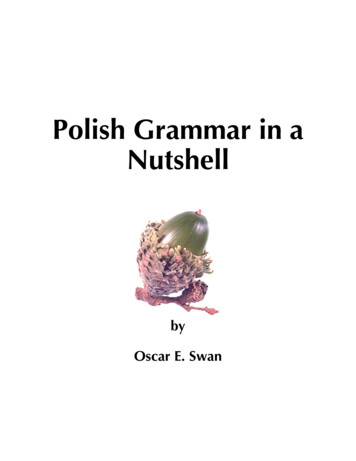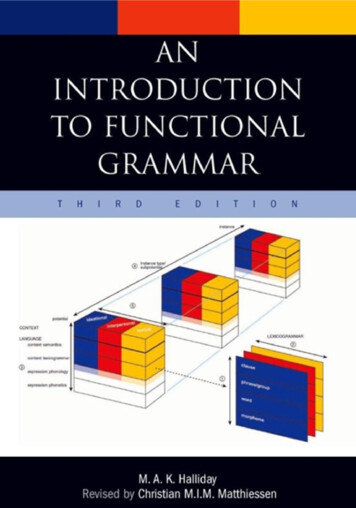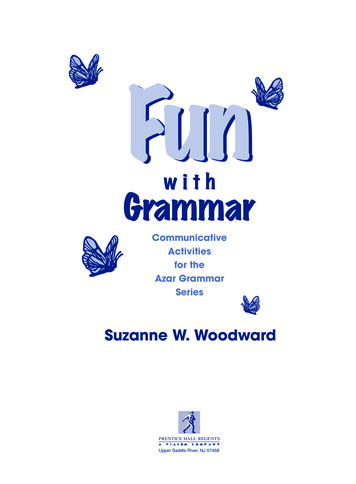
Transcription
A Concise Polish Grammarby Ron F. Feldstein SEELRC 2001
1A Concise Polish GrammarRonald F. FeldsteinContentsIntroductionChapter 1. Polish Sounds and SpellingChapter 2. Major Types of Morphophonemic AlternationsChapter 3. The Polish NounChapter 4. Polish Adjectival Declension and Comparison. Notes on the Adverb.Chapter 5. The Polish NumeralChapter 6. Polish PronounsChapter 7. The Polish Verb: Conjugation and Notes on Aspect
2AcknowledgementI would like to acknowledge the help of Charles Townsend, of Princeton University, and FrankGladney, of the University of Illinois, who patiently read through earlier versions of this grammar andpointed out many errors and inconsistencies in my exposition. In fact, they provided so many helpful andvaluable suggestions that it would be impossible to offer separate attributions for each instance wheretheir ideas have made their way into the final version. Therefore, I would like to express my gratitude atthe outset and add that I bear the responsibility for any remaining errors that have not been corrected.
3IntroductionThe following grammatical sketch of Polish, designed for use on the Internet, attempts to covermany of the important points of Polish sounds and spelling and morphology, plus selected points in theareas of syntax and usage. It is neither complete nor designed for a sophisticated linguistic audience.Rather than use IPA (International Phonetic Association) or scholarly symbols, standard Polishorthography has been used wherever possible in discussions of the sound system. Nevertheless, I havetried to make all statements accurate, while deviating, in some respects, from traditional school grammars.For example, the morphological discussion of cases according to Roman Jakobson's morphologicalstudies: nominative, accusative, genitive, locative, dative, instrumental--in preference to the olderordering of nominative, genitive, dative, accusative, instrumental, locative. Jakobson’s ideas have alsoinfluenced the presentation of the Polish verb, which is based on the notion that the entire verbal paradigmcan be derived from a single stem. Although these Jakobsonian ideas are already found in many scholarlytreatments of Polish and other Slavic languages, they are still somewhat rare in presentations designed forgeneral audiences. Thus, this grammatical sketch tries to occupy a middle ground, not attempting to becomprehensive, but aiming at accuracy in its descriptions. While not a substitute for a textbook, it mightprovide a useful review of the sound system and Polish inflection.
4Let us now briefly touch on some of the facts about the Polish language of today. Polish, ofcourse, is the official state language of the Polish Republic (Rzeczpospolita Polska), which, according tothe 1994 census, had a population of slightly under 40 million. The vast majority of the population isethnically Polish (98.7%). Ukrainians constitute slightly more than half of one percent, while other ethnicgroups make up the rest. Many Poles (referred to as Polonia) also reside outside the borders of Poland.Significant numbers can be found in the United States, Canada, and Australia, as well as in theneighboring countries of Lithuania, Ukraine, and Belarus.The Polish language belongs to the West Slavic branch of the Slavic language family. Other WestSlavic languages are Czech, Slovak, and Upper and Lower Sorbian. The earliest written records of thePolish language date back to the end of the 13th century A.D. Earlier Polish writing exists, but only in theform of individual Polish words within Latin texts. The very important cultural and religious connectionto Latin is related to the fact that Poland, though geographically in Central Europe, is Roman Catholic.While the Orthodox Slavs (Russians, Ukrainians, Serbs, Bulgarians, and Macedonians) use the Cyrillicalphabet of the older Church Slavonic texts, the Roman Catholic Slavs chose the Latin alphabet. The 16thcentury marks the period of the ascendancy of the Polish language as a written language in its own right.Polish uses the Latin alphabet to this day, but since it has many sounds which were lacking in Latin, manyspecial symbols and combinations of symbols have had to be devised to render them. In the realm ofgrammar, Polish is marked by a complex inflectional morphology: a large inventory of grammaticalforms and a significant number of stem alternations, conditioned by a wide variety of grammaticalendings. While Polish is perhaps the most complex Slavic language in terms of its consonant and vowelalternations, its accentual system is one of the simplest, with a regular stress on the next-to-last syllable ofthe word and no distinction between long and short vowels.Poland has had a turbulent history, several times losing and then regaining its national autonomy.The Partitions of 1772, 1793, and 1795 divided Poland among Prussia, Austria, and Russia. Obviously,the Polish language played a key role in keeping the idea of a Polish nation alive during these periods. In1918, after World War I, Poland was reconstituted as an independent nation, only to lose it and fall underboth German and Soviet occupation during World War II. After a brief period of true independencefollowing World War II, Poland entered the Cold War period of domination by the Soviet Union, duringwhich it languished under Soviet style communism for more than 40 years. The era of Soviet dominationended at the beginning of 1990, when Poland changed its official name from the Polish People’s Republicto the Polish Republic. In 1999, Poland joined the NATO alliance, an act which would have beenunthinkable during its long years of membership in the Soviet-ruled Warsaw Pact.
5Chapter 1. Polish Sounds and SpellingI.The Polish Alphabet and SoundsPolish uses the Latin alphabet, as does English. However, certain letters have a differentsound value in Polish, and certain groups of letters are used in ways unknown to English. Inaddition, a series of diacritical marks are used in Polish spelling. This is connected with the factthat Polish has many more consonants than English and many of the other languages which usethe very same Latin alphabet. The additional symbols allow Polish to continue to use the samebasic alphabet as English and many other languages of the world. Polish symbols (includingsingle letters and combinations of two letters, known as digraphs) can be divided into those whichrepresent sounds more or less similar to General American English counterparts, and those whichcannot be easily compared to American English sounds. It should be noted that when “English”sounds are referred to without further qualification, General American English will be understoodas the regional variety.A. Polish letters which represent sounds roughly comparable to those of English.Polish LetterPolish ExampleEnglish ntstepttenstemututoo(The Polish letters ó and u represent the same sound.)wwatavanysynsinzzazoodznodzenods
6When learning the pronounce the above Polish sounds, the English speaker must take special carenot to pronounce Polish initial p/t/k with the aspiration (puff of air) that automatically occurs after thesesounds in English, at the beginning of a word. In order to approximate the Polish sound, the English p/t/kafter s can be used as a better model than initial p/t/k. In other words, the p/t/k of English spot/stem/skinare closer to Polish than the same sounds in English pot/Tom/kin. Therefore, if an English speakingperson pronounces such words as pot/Tom in front of a lit match, the flame should be blown out, as aresult of the aspiration. This should not happen with the initial p/t/k/c of Polish (e.g. pot/ten/kawa/cała)or the initial consonants of English spot/stem/skin.B. Polish consonant sounds that are different from English.The second group of Polish symbols (single letters or digraphs) contains sounds which have noclose English counterparts. Therefore, they require more effort and practice on the part of theEnglish-speaking learner. Descriptions of the sounds, together with examples for practice, have beenlisted in the following sections.1. The dental/alveolar/palatal series of Polish.One of the most important consonantal features of Polish sounds and spelling is the fact that thefour familiar consonants t, d, s, z, each occurs within a series of four consonants. The four seriesare as follows:DentalAlveolarPalatalPalatal dzi3. s-seriessszśsi4. z-serieszżźziIn numbers one and two, the symbols t/d are stops; all others represent affricate sounds, in the dental,alveolar, and palatal places of articulation. An affricate is a sound that is perceived as a single unit byspeakers, but consists of two separate consonants, much as English ch can be treated as t plus sh. Rownumber one is voiceless and number two is voiced (based on presence or absence of vocal cordvibrations). Rows three and four represent voiceless and voiced fricatives, respectively. Similarly, rowthree is voiceless and row four is voiced. As one can see, the method of spelling the dental, alveolar, andpalatal types in each of the series is a bit different. For example, series two uses two letters for theaffricate dz, but series one uses the single letter c for the voiceless variety of that affricate (even though itis phonetically equivalent to ts). Likewise, alveolars and palatals can be symbolized either by digraphs(sequences of two letters), by a diacritic over the letter, or a combination of both.
7One particularly acute problem for English speakers is caused by the fact that the differencebetween alveolars and palatals is not used contrastively in different English words, while it is in Polish.In fact, this distinction occurs in all of the four above illustrated series of Polish, so it is very common andimportant for learning the language properly. Let us take the first series as our first example. Polish calone represents the dental sounds [ts] and is an affricate. Polish cz, as in czasopismo ‘magazine’,represents a Polish sound reminiscent of the English digraph ch, as in chair. However, another Polishsound, represented by the letter ć, also strikes the English-speaking hearer as a ch-sound and similar to thefirst sound of English chair! The difference between these sounds is insignificant for English, butimportant for Polish. In terms of phonetics, the two sounds differ on the basis of different types of contactof the tongue and the palate. In the case of Polish cz, the tip of the tongue contacts the alveolar ridge,located right behind the upper teeth. Therefore, cz is referred to as an alveolar sound. On the otherhand, Polish ć displays a long strip of contact between the middle part of the tongue and the palate(located behind the alveolar ridge). Unfortunately, the English ch sound can sound similar to eitherPolish cz or ć, since there simply is no such distinction in English.The very same situation of having two different Polish sounds that cannot be distinguished inEnglish applies not only to the Polish consonant pair cz/ć, but to dż/dź, sz/ś, and ż/ź as well. The Englishspeaker will often consider that both dż and dź recall the g of gem, that both sz and ś sound like Englishship, and that both ż and ź sound like the spelled z of English azure.In order to show the difference between the Polish sounds, the following articulatory diagrams1first show the tongue position for the continuants (sz, ż) and for the first component of non-continuants(cz, dż) of the alveolar series. Then, the palatal continuants (ś, ź) and first component of non-continuants(ć, dź) are shown. Only the first components are shown for non-continuants, since they are affricates,rather than stops, and thus consist of a first component stop, and a second component fricative, whichappears as the illustrated continuant for the same place of articulation. In other words, a depiction ofaffricate articulation requires at least two diagrams.1The four articulatory diagrams are adapted from Wierzchowska (1967:95, 147).
8Alveolar Series:Continuants sz, ż:
9First (stop) component of non-continuants cz, dż:
10Palatal Series:Continuants ś, ź:
11First (stop) component of non-continuants ć, dź:As noted above, the distinction between the alveolar and palatal sounds of Polish is an extremelyimportant one for the learner to master, since there are many such pairs of sounds that are opposed by thisfeature. Polish has one of the largest inventories of sounds of this type, with a total of eight. Besides czand ć, there are the above illustrated pairs dż/dź, sz/ś, and ż/ź.1. The Polish digraph dż representing an alveolar sound, as in the word dżem ‘jam’, has an initialsound like that of Polish czas, except for the fact that it is voiced. But, there is also a similarsounding Polish palatal dź, as in dziki ‘wild’, which has a tongue position exactly like that ofć, but it is voiced, which means that the vibrations of the vocal cords can be heard during itspronunciation.2. Voiceless alveolar fricative sz occurs in szary ‘gray’. Palatal ś, as in oś, differs from sz on thebasis of palatal/alveolar as well.3. Voiced alveolar fricative ż occurs in żart ‘joke’. Polish voiced palatal fricative ź has the sametongue position as the other palatals ć/dź/ś. The word źle ‘badly’ is an example of its use.Notice that the digraph rz has the same value as ż and that the words spelled morze 'sea' andmoże 'he/she can' sound exactly alike. The reason for the difference lies in the histories of the
12words with the two kinds of spelling. The diacritic mark (called kreska in Polish) shared byś/ź/ć is a symbol which signifies that the place of articulation is palatal.A very important spelling rule applies to the palatal sounds ć/dź/ś/ź. They are written this way,with the diacritic kreska, only when no vowel immediately follows them. Otherwise, i.e. when a vowelfollows, these palatal sounds are written with no diacritic and the following vowel i instead of the mark .Thus, ć/dź/ś/ź are always written before consonants and at the end of a word, while ci/dzi/si/zi must bewritten before vowel sounds. In other words, the following spellings are used when palatals are followedby the vowels aziezioziuThe phonetic value of the above spellings is [ća dźa śa źa], etc., but these phonetic spellings arenever used as such in Polish. When a Polish word contains a palatal consonant which is followed by thevowel i itself, the i-symbol does double duty. It both signals that the consonant is a palatal and alsorepresents its own vowel sound of [i]. Thus, ci/dzi/si/zi with no other vowel following are spelled insteadof *ći, *dźi, *śi, *źi, which do not occur in spelling. (Note that the symbol * is used to show that acombination is incorrect and does not occur.) For example, ziarno/siano/ciastko represent the sounds [ź ść] before the vowel [a]. The words zima/siwy/cicho represent the very same palatal consonants followedby the vowel [i]. Polish spellings ci/dzi/si/zi should never be confused with the letters for dental soundsc/dz/s/z, since the latter sounds can never be followed by the vowel letter i in Polish; similarly, c/dz/s/zcan be followed by the vowel letter y, but the sounds [ć/dź/ś/ź] can never precede y, e.g. ci 'those'(phonetically [ći], but cyna 'tin' (phonetically [tsyna]).Examples.A. [cz] vs. [ć]czapka ‘cap’czas ‘time’czemu ‘what, dative’miecz ‘sword’czelo ‘cello’czek ‘check’Czech ‘Czech’B. [dż] vs. [dź]vs.ciało ‘body’ciasto ‘dough’ciemno ‘dark’mieć ‘to have’cielak ‘calf’ciekł (colloquially with silent ł) ‘it leaked, masc.’ciecz ‘liquid’dżem ‘jam’radża ‘rajah’dżet ‘jet’dżuma ‘plague’vs.dzień ‘day’radzić ‘to advise’dzieci ‘children’dziura ‘hole’
13C. [sz] vs. [ś]szara ‘gray, fem.’szron ‘frost’kasza ‘cereal’szach ‘Shah’szok ‘shock’kosz ‘basket’wiesz ‘you know’proszę 'please'vs.siara ‘colostrum’środa ‘Wednesday’Kasia ‘Katy’siak ‘that way’sioło ‘hamlet’koś ‘mow, impv.’wieś ‘village’prosię 'suckling pig'vs.ziarna ‘grains’ziemia ‘land’ziać ‘pant’zielony ‘green’zimno ‘cold’D. [ż]/[rz] vs. [ź]żarna ‘handmillrzemień 'strap'żaba 'frog'żel 'gel'Rzym 'Rome'2. Other Polish consonant letters which require additional explanation are as follows:A. Polish symbols ch and h.These symbols, as in Polish chcemy 'we want', hasło 'slogan', represent the ch sound often heard inthe correct (German) pronunciation of the composer Bach’s name. Phonetically, it is a voicelessvelar fricative, a sound that might be heard if an English k is stretched out in time, so it lastslonger than usual. Polish ch and h represent the same sound, but the letter h is frequently used forwords that were not originally Polish, but borrowed from another language. Some examples ofthese letters are as follows:chata ‘hut’chłodny ‘cool’hak ‘hook’huk ‘roar’suchy 'dry'ucho 'ear'chudak ‘poor wretch’hałas ‘din’B. l, as in nauczyciel, which requires the usual Polish alveolar pronunciation, i.e. anu-shaped tongue tip along the contours of the alveolar ridge, similar to cz, except that it is anl-sound, known as a lateral. It is much closer to the l of an English word such as lean, rather thanthe final l found in the English word wall, which would be quite incorrect for rendering Polish l.Remember that the Polish barred ł is pronounced like English w by most Polish speakers.
14Examples of [l] vs. [ł]:lak ‘sealing wax’lasy ‘forest'klasa ‘class’talk ‘talc’ból ‘pain’dali ‘they gave (virile)’chleba ‘bread (gen.)’vs.ława ‘judicial bench’łasy ‘greedy (for)’kłamać ‘to lie’tłusty ‘fat’bałwan ‘idol’dały ‘they gave (non-virile)’chłopa ‘peasant (gen.)’C. Polish ń, as in koń, is a palatal n-sound, with a tongue position similar to that ofć/dź/ś/ź. It sounds the palatal n spelled ni in the English word onion. In Polish, the use of i after nperforms exactly the same function as after the letters c/dz/s/z before vowels, as described above.In other words, ni/nie/ni/nio/niu are written instead of *ńi, *ńe, *ńi, *ńo, *ńu, which do not occuris spelling. The letter ń is spelled as such only when palatal [ń] has no vowel immediatelyfollowing, at the end of a word or before a consonant.Examples of [n] vs. [ń]:dnem ‘bottom (inst.)'vs.nosa ‘nose, genitive’stan ‘state’wstanę [wstane] ‘I’ll get up’dniem ‘day (inst.)’niosła ‘she carried’wstań ‘get up (impv.)’wstanie ‘he/she will get up’D. The letter r, as in rysunek, is of the trilled variety, totally unlike the r of American English.The tip of the tongue vibrates against the alveolar ridge when Polish r is pronounced.E. The Polish digraph rz, which sometimes alternates with r in Polish grammatical forms, isequivalent in sound to Polish alveolar ż, as in żart. The spelling of rz and ż must be carefullynoted, in view of their identical value.Examples of [r] vs. [rz]:ruta ‘route’rekord ‘record’rada ‘advice’wrona ‘crow’vs.rzut ‘throw’rzepa ‘turnip’rzadko ‘seldom’wrzos ‘heather’Examples of similar sounds with rz and ż spellings:porze 'season (loc.)'rzepy 'turnips'rzadko 'rarely'pożar 'fire'żeby 'in order to'żaba 'frog'
15C. Polish vowels that are different from English: nasals.The chart at the beginning of this section indicates that six of the Polish vowel sounds (and letters)are comparable to those of English: i/y/u/e/o/a. However, two of the Polish vowel letters, ą and ę,require special explanation. Their basic value is that of nasal vowels. In spite of its appearance, the letterą represents a nasalized o-sound, and not a nasalized a-sound! The letter ę represents a nasalized e-sound,as one might expect. The most important fact about the phonetic value of ą and ę is that their actualpronunciation depends on the sound that follows them. The following sections address the majorpositional variants of nasal vowels and consonants.1. Pre-fricative and word-final position.The nasal vowel letters are pronounced as nasal vowels only before fricative consonants (i.e.f/w/s/z/sz/ż/ś/ź/ch, e.g. wąsy, język, książka) and in final position (e.g. biją, wezmą). However, word-finalę can be pronounced as a nasal in the formal speech style, but is usuallly oral [e] in conversational speech;i.e. written biję/wezmę are pronounced as if they were [bije], [wezme]. Nasal vowels that occur beforefricatives are sometimes inaccurately portrayed as synchronic, meaning that that the identical nasal vowelsound occupies the entire vowel. However, research has shown that the nasal vowels of standard Polishare really asynchronic (Dukiewicz 1967:68), i.e. they are really diphthongs, with a difference ofpronunciation in the first and second parts of the vowel.2 The usual asynchronic pronunciation contains anon-nasal vowel in the first part of the sound, followed by the nasalized glide [w̃] in the second (e.g. język'language', pronounced as [jew̃zyk]; mąż 'husband', pronounced as [mow̃sz]). In cases where the nasalvowel ę is followed by a palatal fricative ([ś] or [ź]), the nasal glide can optionally appear as [j̃], e.g. gęś'goose', pronounced as [gej̃ś].3Examples: nasal vowel letters preceding fricatives and of final -ą. The phonetic value is either[ow̃], [ew̃], or [ej̃], as indicated:[ow̃]:wąchać ‘to smell’wąsy ‘mustache’chcą ‘they want’robią ‘they do’tą ‘this (fem. inst.)’książka ‘book’siąść ‘to sit down’dążyć ‘to reach on time’krążyć ‘to wander’wąwóz ‘canyon’2[ew̃]:mięso ‘meat’węszyć ‘sniff around’często ‘often’język ‘language’rzęchy 'ragged clothing'węch ‘sense of smell’mięso 'meat'Conservative prescriptive Polish sources condemn any diphthongal nasality (i.e. both [w̃] and [j̃]) as incorrect (Karaś andMadejowa 1977:XXVIII), insisting on the uniform, monophthongal nasals [o ] and [ę].3There is quite a bit of variation in prescriptive statements about Polish nasals. Schenker (1973: 347) specifies only [ew̃] asthe phonetic value of the nasal vowel in gęś and więzienie, while Biedrzycki (1963:37) gives it as [j̃].
16[ej̃] occurs in the case of ę before palatals:gęś 'goose'więzienie 'prison'mięsie 'meat (loc. sg.)'2. Before non-continuants (pre-stop and pre-affricate).Before stop consonants (p/b/t/d/k/g) and affricates (c/dz/cz/dż/ć/dź), nasal vowels represent asequence of two sounds. The first is simply the vowel [e] (in the case of ę) or [o] (in the case of ą); thesecond portion of the nasal articulation matches the consonant in point of articulation. Therefore, labial[m] occurs before labials ([om]/[em] in the combination ąp/ęp); dental [n] before dentals ([on/en] inąt/ęt); alveolar [n ] before alveolars ([on /en ] in ącz/ęcz); palatal [ń] before palatals ([oń/eń] in ąć/ęć); andvelar [N] before velars ([oN/eN] in ąk/ęk). For example:Nasal consonant pronunciation before stops and affricates (non-continuants).SpellingPronunciation(Pre-labial stop)kąpać 'to bathe'[kompać]Also: ząb ‘tooth’, zęby ‘teeth’, trąba ‘trumpet’, bęben ‘drum’, dęby ‘oaks’, sęp ‘vulture’(Pre-dental stop/affricate)kąt 'corner'[kont]Also: sąd ‘court’, ląd ‘land’, trąd ‘leprosy’, ręce ‘hands’, nędza ‘need’(Pre-alveolar affricate)rączka 'handle'[ron czka]Also: pączek 'doughnut', łączka 'meadow', gorączka 'fever', jęczka 'complainer (fem.)'(Pre-palatal affricate)pięć 'five'[p’eńć]Also: giąć 'bend', będzie 'he/she will be'(Pre-velar stop)ręka 'arm, hand'[reNka]Also: bąk ‘spinning top’, łąka ‘meadow’, mąka ‘flour’, ciągle ‘continually’, tęgi ‘stout’
173. Loss of nasal value of ę, ą.As noted above, final ę (but not ą) also loses its nasality in colloquial speech. When eitherof the nasal vowels precedes l or ł, the nasality is also lost and only the vowel sound remains (e.g.giął 'he bent' [g'ow], gięli 'they bent' [g'el'i]; i.e. the ą sounds like o, and the ę sounds like e.4Examples: oral vowel pronunciation ([e], [o]) in place of final -ę and of nasals before l, ł.wezmę ‘I’ll take’niosę ‘I’m carrying’piszę ‘I write’wziął ‘he took’zaczął ‘he began’wzięła ‘she took’wzięli ‘they took, virile’zaczęli ‘they began’4. Nasal consonant letters before fricatives.A corollary to the value of nasal vowel letters specifies that when the nasal consonant n occursbefore fricatives, it is pronounced as the nasal glide [w̃] (e.g. koncha 'conch' is pronounced as [kow̃cha]).5In the case of consonant m, this only happens before labiodental fricatives f/v. The palatal nasalconsonant ń is realized as the front nasal glide [j̃] before fricatives.[w̃]:[j̃]:konferencja 'conference'tramwaj 'trolley car'konsul 'consul'rynsztok 'gutter'pański 'your'koński 'horse (adj.)'tańszy 'cheaper'Note that m before other non-labial fricatives retains its value of [m]: giemza 'chamois', omszeć 'getmossy', czeremcha 'bird cherry tree'.4In formal speech, a reduced degree of nasality before laterals l and ł can also occur (Karaś and Madejowa 1977:XXVIII).In other words, nasal vowels and /n/ contrast phonemically only in word-final position. Otherwise, nasal vowels generallyoccur before fricatives and nasal consonants occur before stops and affricates, regardless of the written letter that is used.5
18D. Consonant palatalization.We have already mentioned the use of i to signal the presence of the sounds [ć, dź, ś, ź, ń], whenspelled after the letters c/dz/s/z/n. Another important use of the vowel i (besides its regular use as a vowelsound) occurs after the labials (p/b/f/w/m) and velars (k/g/ch), where there is a more or less simultaneouspronunciation of j with the labial or velar, known as palatalization. When such a labial or velar isfollowed by i plus another vowel, the i only functions as a signal of palatalization and not a vowel sound;for example, in the words wiara, polskie, we have palatalized w and k, which will be symbolized by usingthe apostrophe, i.e. [w’] and [k’]. Therefore, the phonetic transcription of these words is [w’ara] and[polsk’e].6 The distinction between plain and palatalized labials and velars can be phonemic; i.e. it can bethe only phonetic difference between different words, for example:NonpalatalizedPalatalizedwada 'defect'wozy 'carts'mała 'small (fem.)'Polskę [polske] 'Poland (acc.)'bała się [bała śe] 'she was afraid'pasek 'belt'wiadro [w'adro] 'bucket'wiozły [w'ozła] 'they brought by vehicle (fem.)'miała [m'ała] 'she had'polskie [polsk'e] 'Polish (neut.)'biała [b'ała] 'white (fem.)'piasek [p'asek] 'sand'When labials and velars occur before the vowel [i], they are always palatalized. However, plainlabials and a few instances of the velar [ch] can also occur before a high unrounded vowel, in which casethe vowel is automatically central, rather than front, i.e. it is y [y]. Phonemically, this is explained bystating that each such consonant oppose both plain and palatalized phonemes, and that the high unrounded/i/ has two allophonic variants (front and central), depending on whether it is preceded by a palatalized forplain consonant phoneme. Here are some examples of palatalized labials and the velar [ch] followed by[i], and the corresponding plain labials and velars followed by [y]:Examples of labials and velars followed by the letter i:6Palatalized labial/velar plus [i]Plain labial/velar plus [y]biła [b'iła] ‘she beat’Chiny [ch'iny] 'China'pił [p'iła] ‘he drank’miła [m'iła] ‘dear (fem.)’Wisła [w'isła] ‘Vistula (River)’była 'she was'chyba 'perhaps'pył 'dust'myła 'she washed'wyła 'she howled'Corresponding to palatalized labials preceding vowels other than i, there is an alternative standard pronunciation which insertsj after palatalized labials. Thus, wiara, miara, piętno, for example, can be pronounced either as [v'ara, m'ara, p'entno] or[v'jara, m'jara, p'jentno] (Wierzchowska 1967:136-7, 148,155). This insertion of jot greatly decreases the phonemic use ofpalatalized consonants.
19Note that palatalized k'/g' can be followed by [i], but the combination of plain k/g, followed by ydoes not occur.kij [k'ij] ‘stick’polski [polsk'i] ‘Polish (masc.)gips [g'ips] ‘plaster’drogi [drog'i] ‘expensive (masc.)’II. AccentWith very few exceptions, words are stressed on the next to last syllable (shown as underlined).For example, tablica/student/czasopismo. The word nie is counted as part of the following verbform that it negates, for the purposes of placing the accent. Therefore, the combination nie jest ispronounced as if it were a single two-syllable word with the accent on the first syllable, phonetically[ńejest]. Similarly, prepositions are accentually joined to the following word; e.g. za nim is pronouncedas [zańim].III. Word-final devoicingMany of the Polish consonants occur in pairs, one voiced and the other voiceless, depending onwhether or not the vocal cords vibrate during pronunciation. When paired voiced consonant letters arewritten at the end of Polish words, they are pronounced like their voiceless partners instead. For example,the words written ząb/prąd/róg are pronounced as if they ended in the letters -p/-t/-k, respectively. Hereis a list of the Polish paired voiced and voiceless kfsszścczćWhen a sequence of more than one paired consonant appears finally (e.g. zjazd ‘congress’), note that theentire final group is devoiced, i.e. [zjast].Examples of word-final devoicing:ząb [zomp] ‘tooth’dąb [domp]‘oak’lew [lef] ‘lion’rów [ruf] ‘ditch’zlew [zlef] ‘sink’sad [sat] ‘orchard’trud [trut] ‘difficulty’lód [lut] ‘ice’śledź [śleć] ‘herring’wóz [vus] 'cart'śniedź [śńeć] ‘verdigris’śnieg [śńek] ‘snow’widz [w'ic] ‘spectator’rydz [ryc] ‘type of mushroom’lekarz [lekasz] ‘doctor’aż [asz] ‘as many as’też [tesz] ‘also’mig [mik] ‘instant’Bóg [buk] ‘God’brydż [brycz] 'bridge (game)'
20IV. Voicing assimilationAnother rule connected to voicing and devoicing states that a group of consonants is either voicedor voiceless as a whole, usually depending on the voicing of the last consonant in the group. Forexample, the word torebka presents the spelled group bk, but the group is pronounc
A Concise Polish Grammar Ronald F. Feldstein Contents Introduction Chapter 1. Polish Sounds and Spelling Chapter 2. Major Types of Morphophonemic Alternations Chapter 3. The Polish Noun Chapter 4. Polish Adjectival Declension and Comparison. Notes on the Adverb. Chapter 5. The Polish Numeral Chapter 6. Polish Pronouns Chapter 7.









